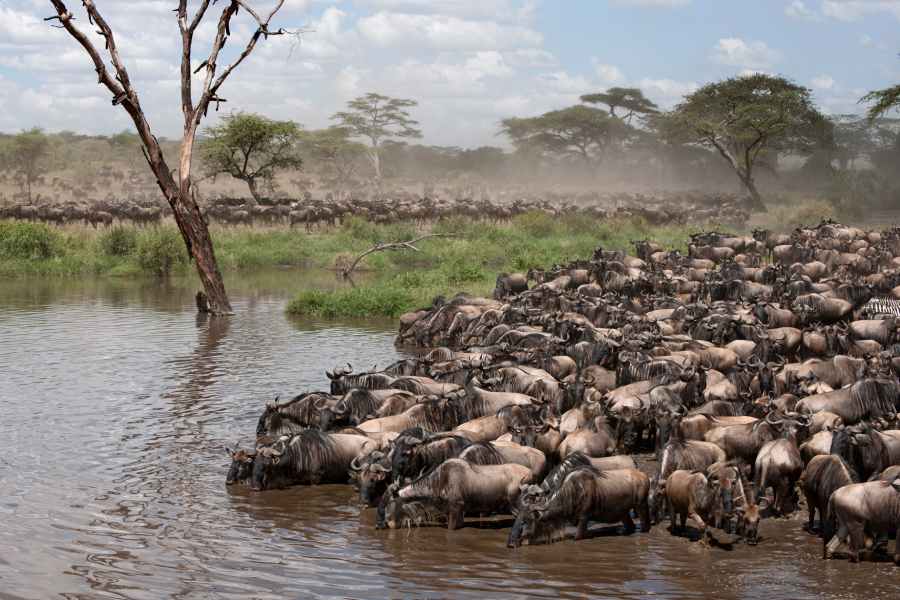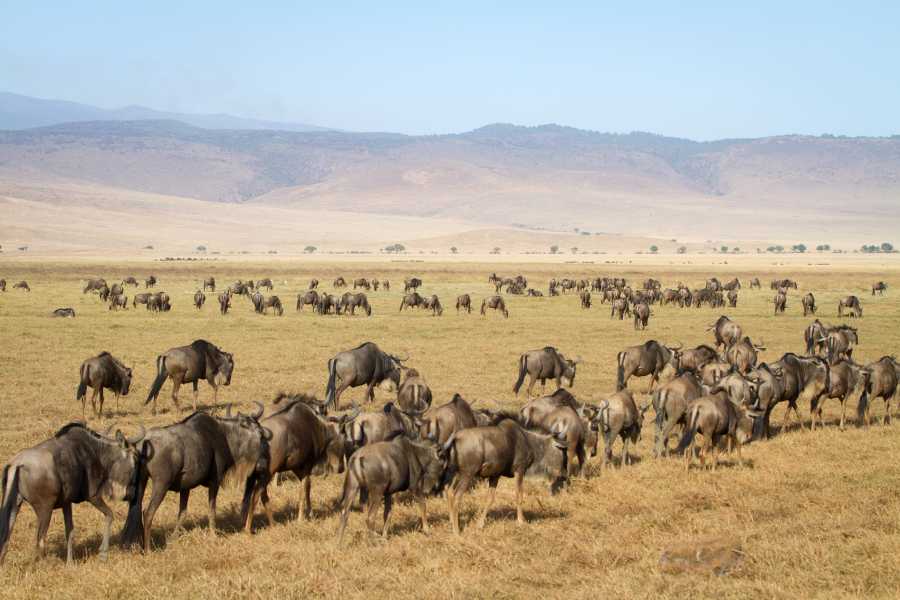On Safari In Tanzania For The Great Migration
Download Travel Details >PRIVATE & SMALL GROUP TOURS TO THE WORLD'S BEST DESTINATIONS
Join Us For A Safari In Tanzania

What Is The Great Migration?
 The Great Migration is one of the most amazing sights to see on the African continent! But what is this annual event, and why do so many Tanzania safari tour packages offer options for wildlife enthusiasts to opt in for a Great Migration safari? Read on to learn more about this natural phenomenon and why it should definitely be on your bucket list of things to see in Tanzania!
The Great Migration is one of the most amazing sights to see on the African continent! But what is this annual event, and why do so many Tanzania safari tour packages offer options for wildlife enthusiasts to opt in for a Great Migration safari? Read on to learn more about this natural phenomenon and why it should definitely be on your bucket list of things to see in Tanzania!
The great wildebeest migration is the largest overland migration of wildlife in the world. This ever-moving circular migration includes wildebeest and other land mammals as they travel across the Serengeti-Mara ecosystem in search of grazing and water. The great herds of wildlife follow an age-old route that begins in the southern part of the Serengeti, by the Ngorongoro Conservation Area, and travels in a clockwise direction toward the Masai Mara in Kenya. Along the way, the animals must protect their newborn calves from predators and other danger like river crossings. After arriving in Kenya and enjoying a season of plentiful grazing, the animals begin their journey back to Tanzania – always following the seasons and always in search of food.
Following The Animals On Their Migratory Journey
Many people think the Great Migration is a once-a-year journey, but in reality, the animals are traveling in search of food and water all year long! Each season offers adventurers on Tanzania safari trips a unique wildlife experience. The Great Migration is a never-ending journey that runs in a clockwise circle and covers approximately 1,800 miles each year. From the southeast grasslands region to the northwest woodlands and back again, there is plenty of wildlife viewing opportunities for those interested in the Great Migration and Tanzania safari tour packages. Some of the most popular destination spots for Great Migration safari tours include the Serengeti National Park, Ngorongoro Conservation Area, Loliondo Game Managed Area, and the Grumeti Reserve.
Five Fun Facts About The Great Migration
- Deep in the Serengeti National Park is the world’s oldest ecosystem. This unique biosphere is home to a diverse range of both plants and creatures that cannot be found anywhere else on the planet!
- One of the biggest dangers wildlife face during the Great Migration is the Mara River crossing. Crocodiles lie in wait for their prey in the river and drown them by seizing their victim and pushing them below the water. Some crocodiles even use their tails to grasp prey.
- More than 1.5 million wildebeest and approximately 200,000 zebra travel across Tanzania and Kenya during the Great Migration.
- Wildebeest and zebra are two of the few species of wildlife that can live in the same area because they eat different parts of the same species of vegetation and do not need to compete for food.
- More than 3,000 lions follow the migratory herds across the Serengeti during the Great Migration, waiting for their chance to pounce on the weakest link.

When Is The Best Time To See The Great Migration In Tanzania?
Since the Great Migration’s route covers almost seven months of the year in Tanzania, there are plenty of opportunities to see wildlife at different stages of their journey. It just depends on where the Tanzania safari tour packages have scheduled visits for adventurous travelers, and what you want to see along the way. Here is a breakdown of the stages of the Great Migration by season, to help you decide when you might want to book a Great Migration safari:
The Great Migration in January, February, and March
In January, the Great Migration begins a southward trek along the eastern edge of the Serengeti toward the Ngorongoro Conservation Area. Here the great herds of animals expand, as new calves are born. The plains in the Ngorongoro are rich in nutritious grass, which provides the animals with plenty of food to raise the newborn calves. Each year, 400,000 calves are born in the Ngorongoro within a period of two to three weeks. That’s nearly 8,000 calves a day! If you want to see the newborn calves during your Great Migration safari, make sure your package includes a stop at the Olakira, Kimondo, or Ubuntu migration camps.
The Great Migration In April and May
After the newborn calves have matured, the wildlife herds continue their journey northwest toward the central Serengeti, where the grass is fresher and more plentiful. Mating season begins toward the end of May, with male wildebeest battling for the affection of the females in the herd. One of the few camps in this area to offer viewing opportunities at this stage of the Great Migration is Dunia Camp. Throughout the rut, the animals continue their movement along the Serengeti’s Western Corridor. Here, they will cross the Grumeti River. Pro tip: May is a slow time for safari trips in Tanzania. Tanzania safari trips are generally less expensive at this time of year, yet the wildlife viewing is still excellent!
The Great Migration In June and July
June marks the beginning of the dry season in the Serengeti. After crossing the crocodile-infested Grumeti River, the wildebeest and their companions head north along the western edge of the park toward the Mara River. This river marks the boundary between Tanzania and Kenya, and to watch the crossing of the great herds here is one of the most exciting wildlife events on Earth! The best place to see the Great Migration in the northern part of the Serengeti is at Sayari Camp.
When Does The Great Migration Return To Tanzania?
For the next three months, the Great Migration winds across Kenya as the animals search for good grazing spots. But as the resources dwindle, they begin making their way back to the Serengeti. The rains arrive in Tanzania in November, drawing the herds back to the rejuvenated plains in the Southern Serengeti. Once back, the herds scatter into widely spaced groups on the open plains, grazing and gathering at seasonal waterholes. That is until the next Great Migration begins again in January!

